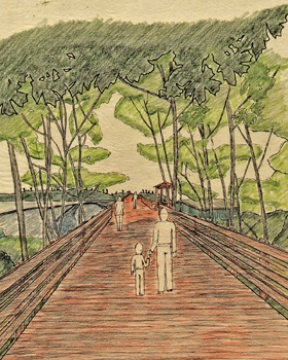A student team aimed to improve the park’s utility, aesthetics.
Behold, the potential future of Pritchard Park.
To the east, a field of spinning windmills. To the south, better connected trails. At its center, a lighted path.
And in park-goers’ ears, the voices of islanders, recounting with zeal – via personal MP3 players and downloadable audio files – the varied history of the 49 acres at the southeastern tip of Eagle Harbor.
“This is just an example,” said Caroline Majors – a University of Washington student who with fellow student Micki Fujikawa came up with the idea of using the latest personal audio technology to impart the park’s history to visitors – before playing a sample clip at City Hall on Wednesday.
“We don’t have any stories yet. But we’re betting you have some great stories to tell.”
The suggestion was just one of many offered by a group of graduate students from the UW’s College of Architecture and Urban Planning.
Under the tutelage of instructors Manish Chalana and Meriwether Wilson, the students have spent the past two months crafting several different visions for the park, all of which were presented at Wednesday’s meeting.
Though all the visions aim to integrate the many different components of the park – the developing Japanese internment memorial, upland forest, beach and a federal Superfund site – into a user-friendly whole, none will be adopted as preferred alternatives.
That will come later, after extensive review by a special committee and the community.
“This is a great springboard,” said Barb Trafton, co-chair of a citizen committee formed by the park district this spring to guide design.
“There are a lot of great ideas that came out of this, but it’s important people know that they’re just ideas, not guidelines,” she said.
The presentations, including images and descriptions of the work, will be posted on the park district’s website next week.
The committee – composed of park neighbors, park district planners and other community members – will analyze the ideas generated by the students to determine which of them should be incorporated into the park’s preferred alternative, which is expected this fall.
Public meetings will be scheduled this summer.
“Our real charge at this stage is to evaluate and guide the work of the students,” said Pritchard Park neighbor and committee member Bob Selzler. “We didn’t want to be too restrictive.”
Which is how iPods, windmills and a host of other ambitious suggestions found their way into the mix.
Along with being inexpensive and easy to produce, Majors and Fujikawa said the oral histories would be easily changeable over time.
Students Shruthi Kantharaj and J.D. Tovey suggested placing several windmills – which in addition to generating a small amount of power could have symbolic meaning – on a portion of the park referred to by the design team as “the point.”
“We think windmills are an appropriate symbol of Bainbridge Island’s conservationist soul,” Tovey said. “Having them there would be like saying, ‘this is who we are, this is where we’re going.’”
Point taken
Historically the point has had several uses, including a period of time as a creosote plant. It has since been designated a federal Superfund site, and now is being restored by the U.S. Environmental Protection Agency and the state Department of Ecology.
A separate, five-year Superfund site review by the EPA is underway now, with a public comment period planned for September.
Students said the ongoing restoration work presented a design challenge because it restricts access to the site for an undetermined period of time.
But the point also was the breeding ground for their most striking ideas, in part because for ferry riders it marks the visual entrance to Eagle Harbor.
One group suggested large art fixtures above the many wells scattered across the site; another proposed a large, elevated trestle that would protrude from the hill above to the edge of the point, offering panoramic views to park-goers, and serving as an “iconic gateway monument,” said student Ion Arai.
Though the feasibility of some of the ideas remains to be seen, committee member Adin Dunning is impressed with the early work.
“I think it’s fair to say that as a group we never would have come up with some of the ideas the students came up with,” he said.
Dunning, who lives at Island Center, brings his two young children to the park for picnics. He likes the idea of viewing the point as the gateway the harbor. He also likes the iPod idea.
“I think it’s an interesting way to interpret the site without just slapping up traditional narrative panels,” he said.
Selzler, like many others, frequents the park with his dog. He hopes the park will remain dog-friendly.
“There’s a big user group there already,” he said, noting that not many island parks have off-leash areas.
He’d also like to see the park’s recreational value improved, with the addition better trails and amenities like canoe and kayak access and, perhaps, small boat storage.
“There are probably some people out there who would like to see us put a chain-link fence around it and give it back to the birds and otters,” he said. “But it’s not a virgin piece of land, ecologically. It’s changed a lot over the years.
“I think it’s incumbent on us to make it as accessible and inviting as we can.”



